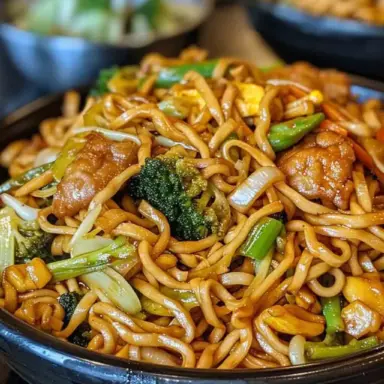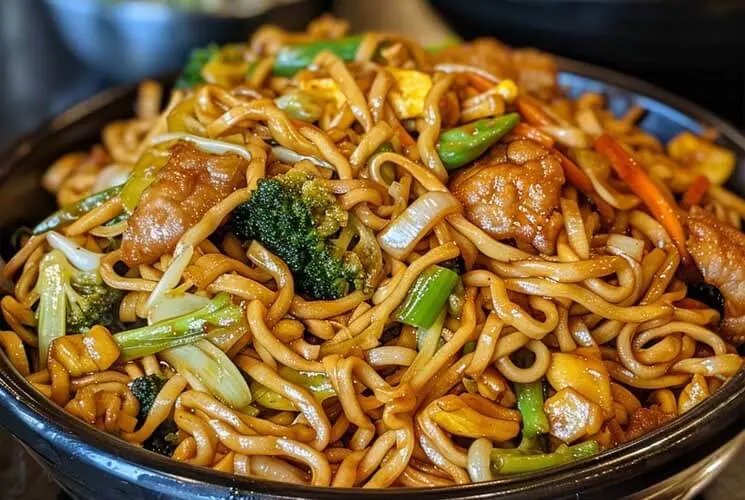Lo Mein is one of those comforting dishes that hits the spot every single time. With its savory sauce, tender noodles, and colorful stir-fried veggies, it’s no wonder Lo Mein has become a favorite in Chinese-American takeout. But here’s the best part—it’s surprisingly simple to make at home!
This beloved dish actually comes from Cantonese cuisine. The term Lo Mein means “tossed noodles,” and that’s exactly what happens at the end—noodles tossed with a rich sauce and stir-fried goodies.
Many people confuse Lo Mein with Chow Mein, but there’s a key difference. Lo Mein noodles are boiled and then mixed with sauce and ingredients. Chow Mein, on the other hand, involves crispy fried noodles.
Making Lo Mein at home means you control the ingredients, skip the greasy takeout, and enjoy a fresh, flavorful dish that comes together fast. Plus, you can easily customize it with whatever’s in your fridge!
What Makes Lo Mein So Special?
There’s a reason Lo Mein keeps showing up on your favorite Chinese restaurant menus. It’s a comforting combination of chewy noodles, rich umami sauce, and vibrant stir-fried ingredients—all tossed together in one glorious pan.
What really sets Lo Mein apart is its flexibility. You can make it with chicken, beef, shrimp, tofu—or go fully vegetarian. It’s also perfect for cleaning out the veggie drawer: bell peppers, carrots, cabbage, mushrooms… anything goes!
Another bonus? It’s quick. This flavorful noodle stir-fry comes together in just 30 minutes, making it perfect for busy weeknights. One pan, a handful of ingredients, and just like that—you’ve got better-than-takeout magic.
Bold Tip: Use high heat and a wide pan (or wok) to get that delicious restaurant-style stir-fry flavor.
Whether you’re a seasoned home cook or just starting out, this noodle dish is one of the easiest to master—and one you’ll find yourself craving over and over again.
Essential Ingredients Breakdown
The beauty of Lo Mein lies in its simplicity. Here’s a look at the essential components that bring it all together:
Noodles
Traditionally, Lo Mein uses Chinese egg noodles, which are yellow and springy. You can find them fresh or dry in Asian markets. In a pinch, spaghetti or even instant ramen noodles (minus the seasoning packet) are solid substitutes.
Vegetables
Go colorful! Try sliced bell peppers, shredded carrots, snap peas, cabbage, mushrooms, or baby spinach. The key is slicing everything thinly so it cooks quickly and evenly.
Proteins
Lo Mein works beautifully with whatever you have:
-
Chicken (thinly sliced breast or thigh)
-
Beef (flank or sirloin, cut against the grain)
-
Shrimp (peeled and deveined)
-
Tofu (pressed and pan-fried)
Or go all veggie for a meatless meal!
Sauce Ingredients
The sauce is what brings it all together. A basic Lo Mein sauce includes:
-
Soy sauce (salty umami base)
-
Oyster sauce (rich, savory depth)
-
Sesame oil (nutty aroma)
-
Brown sugar (a hint of sweetness)
-
Garlic and ginger (aromatics)
Optional Add-ons
To spice it up, try a dash of chili oil, a spoonful of hoisin sauce, or a squirt of sriracha.
Pro Tip: Slice all your ingredients the same size for quick, even cooking!
Sauce Matters: The Heart of Any Lo Mein
Let’s be real—the sauce is everything when it comes to Lo Mein. It’s the glue that brings all the noodles, veggies, and proteins together into one irresistible dish.
The classic Lo Mein sauce balances salty, sweet, and umami flavors. A typical homemade version includes:
-
Soy sauce – for saltiness
-
Oyster sauce – for deep, savory flavor
-
Sesame oil – for aroma and richness
-
Brown sugar – just a touch for balance
-
Fresh garlic and ginger – for bold, authentic taste
Want to make it healthier or diet-friendly?
-
Use low-sodium soy sauce
-
Swap in tamari for gluten-free
-
Skip oyster sauce for a vegan version and sub in mushroom stir-fry sauce
When should you add the sauce? Toss it in at the very end, once your noodles are in the pan. This helps everything coat evenly without overcooking or burning the sauce.
Quick Hack: Mix your sauce in advance and store extra in the fridge for a speedy dinner any time.
Noodles 101: Picking and Preparing the Right Kind
Let’s talk noodles—because not all are created equal when it comes to Lo Mein.
Best Noodles for Lo Mein
-
Fresh egg noodles (ideal, found in refrigerated Asian markets)
-
Dry Lo Mein noodles (cook like pasta)
-
Spaghetti (a perfect pantry backup)
-
Ramen or yakisoba noodles (ditch the seasoning packet!)
Boiling Tips
-
Cook noodles al dente – they’ll soften more in the stir-fry
-
Rinse briefly with cool water to stop the cooking
-
Toss with a bit of oil to keep them from sticking
Avoiding Mushy Noodles
-
Don’t overcook—test early
Advertisement -
Use tongs to gently toss in the sauce
-
Don’t let them sit in the pan too long once sauced
When you prep your noodles right, the final dish will have that chewy, springy bite that makes Lo Mein so addictive.
Step-by-Step: How to Make Lo Mein at Home
Making Lo Mein at home might seem intimidating at first, but once you try it, you’ll see how quick and easy it really is. Here’s a simple breakdown to guide you from prep to plate.
Step 1: Prep Work
Before you turn on the heat, get everything ready:
-
Slice your veggies and protein into thin, uniform strips so they cook quickly.
-
Boil your noodles just until tender, then drain and rinse with cool water.
-
Mix your sauce ingredients in a bowl—this saves time later during stir-frying.
Pro Tip: Keep all your ingredients close by—Lo Mein cooks fast once you start!
Step 2: Stir-Frying in the Right Order
Heat a large nonstick pan or skillet over high heat. A wok is ideal, but not essential.
-
Cook your protein first with a little oil until just done. Remove and set aside.
-
Add a touch more oil and stir-fry your veggies for 2–3 minutes until crisp-tender.
-
Toss in the cooked noodles, return the protein to the pan, and pour in the sauce.
-
Use tongs to toss everything together until well-coated and heated through—just 1–2 minutes.
Step 3: Get That “Wok Hei” Flavor
To mimic the smoky essence of a wok (called wok hei), use:
-
Very high heat
-
A wide pan with room to breathe
-
Minimal stirring so ingredients get slightly charred
Timing Tip: Don’t overcook the noodles or sauce—they can get soggy. Quick tossing is key!
Flavorful Variations You’ll Love
Lo Mein is incredibly versatile, so feel free to make it your own! Here are some delicious versions to try:
-
Spicy Szechuan Lo Mein – Add chili garlic sauce or Szechuan peppercorns for heat.
-
Chicken & Broccoli Lo Mein – A classic combo that’s always satisfying.
-
Vegetarian or Vegan Lo Mein – Load up on mushrooms, tofu, and bok choy.
-
Shrimp or Seafood Lo Mein – Try scallops or calamari for an ocean-inspired twist.
-
Low-Carb Lo Mein – Use spiralized zucchini (zoodles) in place of noodles.
Fun Idea: Mix and match your proteins and veggies for a new version every time!
Make-Ahead, Storage & Reheating Tips
Lo Mein makes awesome leftovers—and it’s perfect for meal prep too.
Storage
-
Store leftovers in an airtight container in the fridge for up to 4 days.
-
Add a splash of water or extra sauce when reheating to freshen it up.
Best Way to Reheat
-
Skillet method: Heat with a little oil for the best texture.
-
Microwave: Quick, but stir halfway through to heat evenly.
Freezing Lo Mein?
Not ideal—noodles can get mushy. But you can freeze the sauce and pre-cooked proteins!
Meal-Prep Tip:
Cook extra noodles and sauce, then assemble fresh batches throughout the week.
What to Serve with Lo Mein
This dish can absolutely stand on its own, but pairing it with a few tasty sides turns it into a complete, satisfying feast.
Appetizers & Sides
-
Spring rolls (fresh or fried)
-
Dumplings – pork, shrimp, or veggie
-
Hot & sour soup or egg drop soup
Light Salads
-
Try an Asian slaw or a simple salad with sesame ginger dressing
Drinks
-
Jasmine tea (hot or iced)
-
Lemon iced green tea
-
A splash of sparkling water with lime for a refreshing contrast
Entertaining Tip: Serve it buffet-style with different toppings so everyone can customize their bowl!
FAQs
Can I use spaghetti instead of Lo Mein noodles?
Absolutely! Spaghetti is a great substitute when you can’t find traditional Lo Mein noodles. Just cook it al dente for the best texture.
What is the difference between Lo Mein and Chow Mein?
Lo Mein uses boiled, soft noodles tossed with sauce. Chow Mein involves crispy stir-fried noodles, often with a drier texture.
Is Lo Mein healthy?
It can be! Use less oil, add lean proteins like chicken or tofu, and load up on veggies to make a nutritious version at home.
What kind of sauce is used in Lo Mein?
A savory mix of soy sauce, oyster sauce, sesame oil, garlic, ginger, and a touch of sugar. It’s the key to that rich, glossy finish.
Can I make Lo Mein without a wok?
Definitely. A large nonstick skillet or sauté pan works just fine. Just make sure it gets hot enough for a proper stir-fry.

Lo Mein Recipe
Equipment
- Large skillet or wok
- Cutting board & knife
- Mixing bowls
- Tongs or large spoon
- Pot for boiling noodles
Ingredients
For the Lo Mein:
- 8 oz Lo Mein noodles or spaghetti
- 1 tbsp vegetable oil
- 1 cup shredded carrots
- 1 cup bell peppers thinly sliced
- 1 cup shredded cabbage or snap peas
- 1 cup cooked protein chicken, shrimp, tofu, etc.
- 2 cloves garlic minced
- 1 tsp fresh ginger grated
For the Sauce:
- 3 tbsp soy sauce
- 1 tbsp oyster sauce
- 1 tsp sesame oil
- 1 tbsp brown sugar
- Optional: 1 tsp chili garlic sauce or sriracha
Instructions
- Cook the noodles according to package directions. Drain and rinse under cool water. Set aside.
- In a small bowl, mix the sauce ingredients: soy sauce, oyster sauce, sesame oil, brown sugar, and chili paste if using.
- Heat oil in a large skillet or wok over high heat. Add garlic and ginger, sauté for 30 seconds.
- Add your vegetables and stir-fry for 2–3 minutes until crisp-tender.
- Add in your cooked protein, then toss in the noodles.
- Pour in the sauce, tossing everything together with tongs until well coated and heated through (1–2 minutes).
- Serve hot, garnished with green onions or sesame seeds if desired.
Notes
- Substitute Lo Mein noodles with spaghetti, ramen, or yakisoba if needed.
- For a gluten-free version, use tamari and skip oyster sauce.
- Leftovers can be stored in the fridge for up to 4 days.
- Add more sauce or a splash of water when reheating to revive flavor.
- Great for meal prep—double the sauce and keep extra noodles ready to go!

